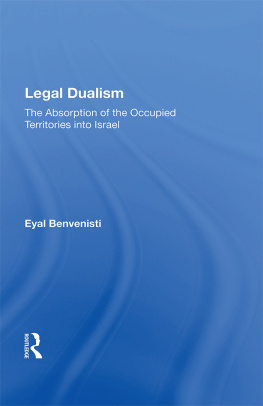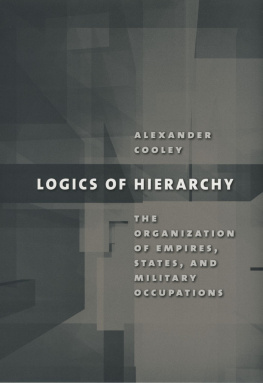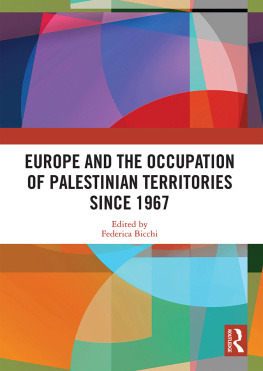THE INTER NATIONAL LAW OF OCCUPATION
The International Law of Occupation
Second Edition
EYAL BENVENISTI


Great Clarendon Street, Oxford OX2 6DP
United Kingdom
Oxford University Press is a department of the University of Oxford.
It furthers the Universitys objective of excellence in research, scholarship, and education by publishing worldwide. Oxford is a registered trade mark of
Oxford University Press in the UK and in certain other countries
Eyal Benvenisti, 2012
The moral rights of the author have been asserted
First published 2012
All rights reserved. No part of this publication may be reproduced, stored in a retrieval system, or transmitted, in any form or by any means, without the prior permission in writing of Oxford University Press, or as expressly permitted by law, by licence or under terms agreed with the appropriate reprographics rights organization. Enquiries concerning reproduction outside the scope of the above should be sent to the Rights Department, Oxford University Press, at the address above
You must not circulate this work in any other form and you must impose this same condition on any acquirer
Crown copyright material is reproduced under Class Licence Number C01P0000148 with the permission of OPSI and the Queens Printer for Scotland
British Library Cataloguing in Publication Data
Data available
Library of Congress Cataloguing in Publication Data
Data available
ISBN 9780199588893
Typeset by Newgen Imaging Systems (P) Ltd, Chennai, India Printed in Great Britain on acid-free paper by
CPI Group (UK) Ltd, Croydon, CR0 4YY
For Haggai and Amir
Preface
Occupation is a state of exception for international law. In a global legal system that allocates public authority among sovereigns on a territorial basis, the law of occupation fills a governance gap that is created whenever a state exercises public power in a foreign land. Such an exercise of authority is inherently suspect due to the intrinsic conflict of interest between occupant and occupied. The regulation of this problematic situation poses unique challenges for international law. This book sets out to explore these challenges, continuing the effort of the first edition to examine the nature of occupation, the authority of the occupant, and the limitations on the exercise of its power.
Because occupation is often the outcome of war, developments in military strategy and in the laws of armed conflict have affected the contents of the law of occupation and the modalities for its enforcement. But the function of the law of occupation extends beyond the need to restrain invading armies, because occupation is intimately related to the concept of sovereignty, a concept this law was designed to protect. Therefore, the development of the law of occupation reflected and, in turn, also influenced the evolution of the law on state sovereignty. Changing perceptions about the identity of the legitimate sovereign (whether the prince or the people) and its authority (does the sovereign have unfettered discretion vis--vis its citizens or is it constrained by human rights obligations?) indirectly led to adjustments in the law of occupation. Positioned at the confluence of two major bodies of international lawthe laws of war and on sovereigntythe law of occupation continues to evolve, notwithstanding the rather rigid textual mold that has defined it since the 1899 Peace Conference at The Hague.
The law of occupation has continued to evolve over the course of the two decades since the publication of the first edition of this book. Normatively, the pull from international and regional human rights law reshaped the authority of the occupant. Institutionally, new tools for monitoring and enforcing compliance with the lawthe emergence of international criminal tribunals and commissions of inquiry and the increasing opportunities and willingness of national and regional courts and human rights bodies to review occupation measuresenhanced the effectiveness of a law that had traditionally suffered from underenforcement. At the same time, however, new occupants have invoked novel and increasingly sophisticated claims to deny the applicability of the law of occupation to their exceptional governance over other peoples lands. These changes have been incremental rather than radical, and several of them could already be anticipated in 1993 when the first edition came out. They concern issues such as the growing role of human rights law, the concept of humanitarian occupation, and the applicability of occupation law to United Nations administration of territories. Two decades later, it is possible to re-examine these issues with the benefit of hindsight.
This new edition is almost twice the length of the original book. It expands on the first in several respects: it offers a historical account on the evolution of the concept of occupation during the eighteenth and nineteenth centuries, it elaborates on the spatial and temporal scope of occupation, and it examines the postoccupation ramifications of occupation measures. It combines analytical chapters with case studies designed to assess both the efficacy of the law and the commitment of the occupants to comply with it. This book adds new contents to the chapters devoted to the occupations of the two World Wars, and updates the account on occupations which continued or commenced after 1993, with three detailed chapters on the Israeli occupation of the West Bank and Gaza, the occupation of Iraq, and the occupation of Kosovo.
The first edition of the book was based on a doctoral dissertation presented to the Yale Law School in 1990. The dissertation benefited from the guidance of Professor W. Michael Reisman, and from the comments of Professors Lea Brilmayer and Mirjan Damaka. Several colleagues commented on one or more chapters of the second edition: Amichai Cohen, Ine Declerck, Guy Keinan, Tamar Meggido, Georg Nolte, Sanja Popovic, and Benjamin Rubin. Guy Keinan, Alex Sorokin and Reut Tondovsky provided careful research assistance. I thank them all. Over the years I benefited from the resources of the libraries of Yale University, New York University School of Law, University of Pennsylvania School of Law, the Max-Planck Institute for Comparative Public Law and International Law, Tel Aviv University, and the University of Munich. I want to thank in particular Maria Smolka-Day, Associate Director of the library at the University of Pennsylvania, and Daniel Wade, the Foreign and International Law Librarian at Yale Law School. A prior version of contains passages which will appear as The Laws of Occupation and Commercial Law Reform in Occupied Territories: Clarifying a Widespread Misunderstanding: A Reply to Jose Alejandro Carballo Leyda in European Journal of International Law (2012).
Lastly, as in the first edition, my deepest gratitude goes to my wife Rivka and our sons, Haggai and Amir, for their continuous and unfailing encouragement and for their inspiration.
Eyal Benvenisti
Tel Aviv
2 November 2011
Contents
AD | Annual Digest of Public International Law |
AJIL | American Journal of International Law |
BYIL | British Yearbook of International Law |
EPIL | Rudolph Bernhardt, ed., Encyclopedia of Public International Law |
FJG | |
Next page










